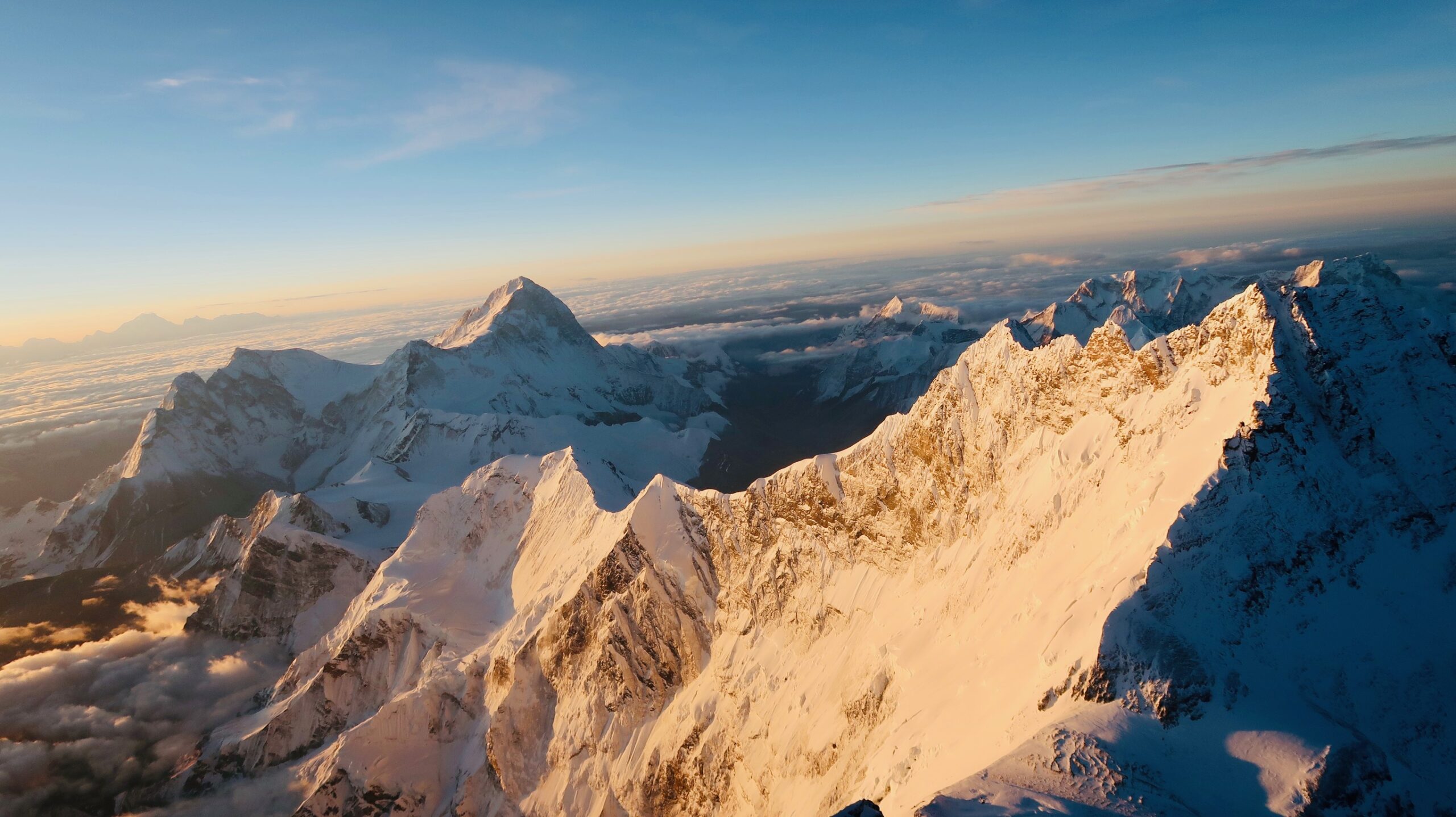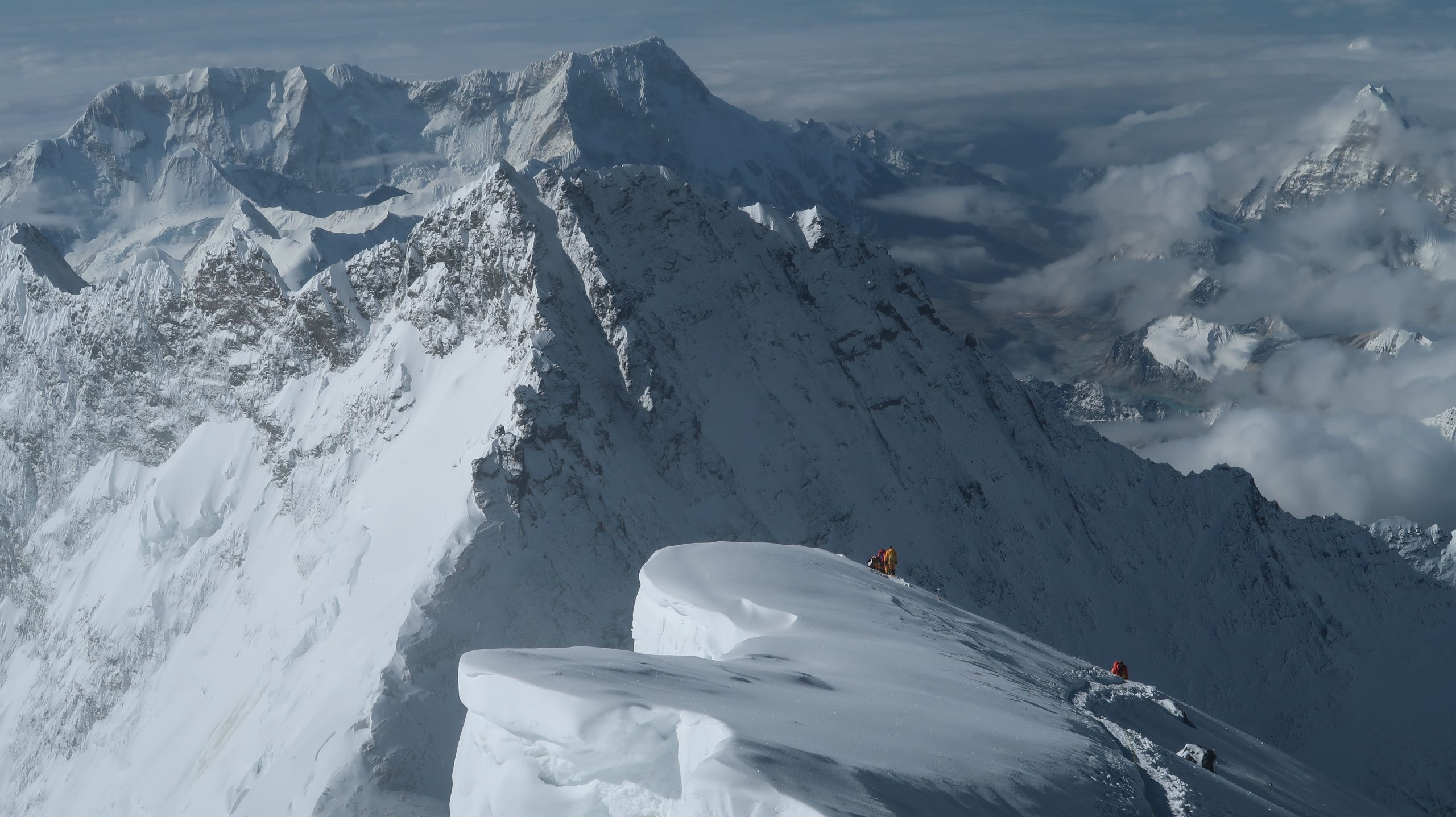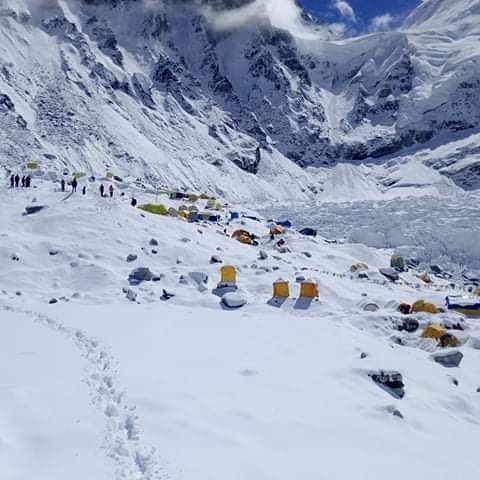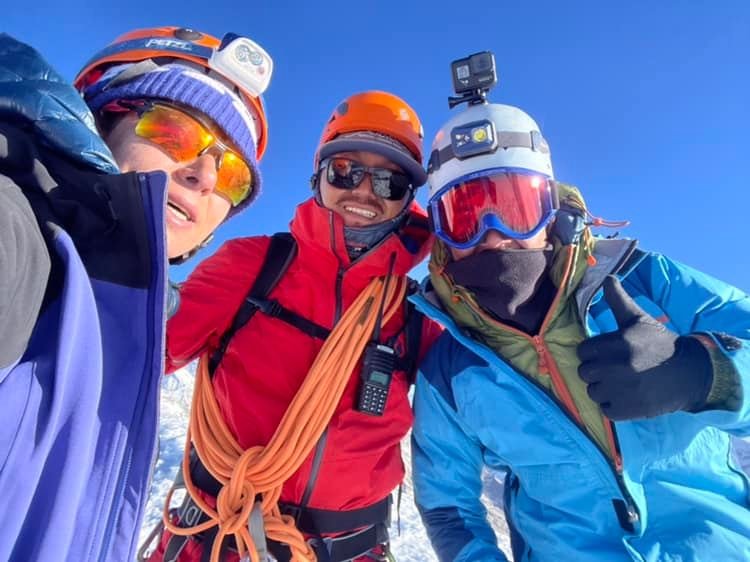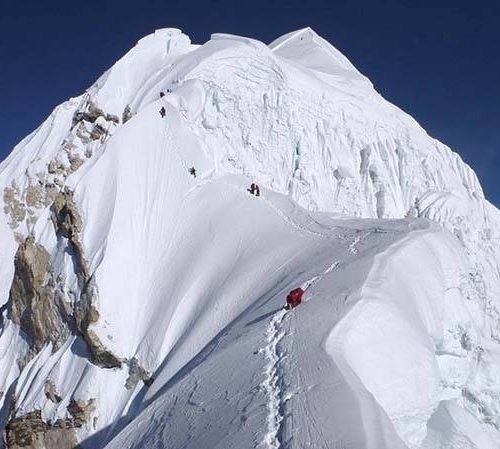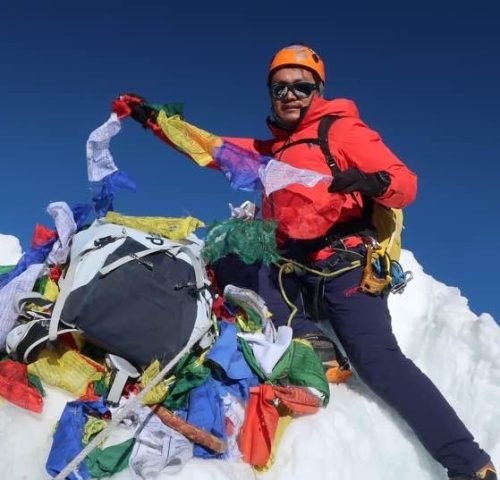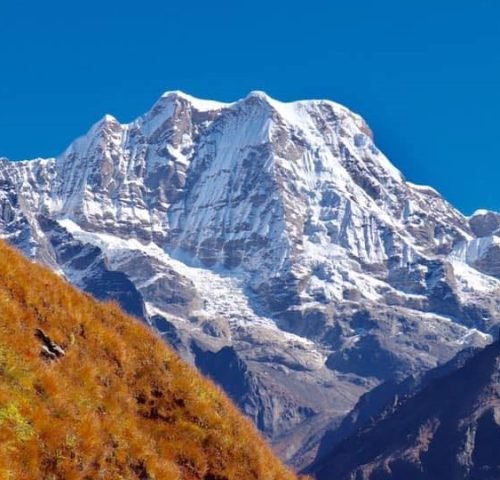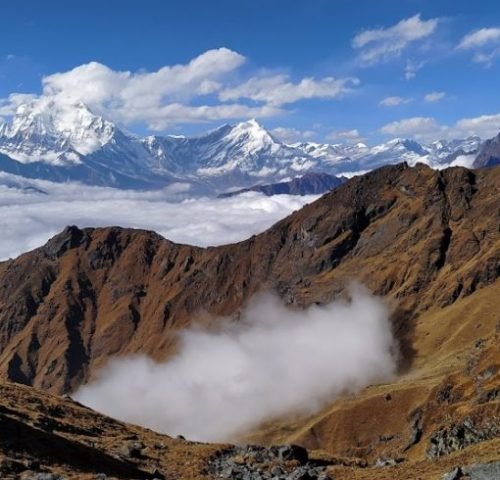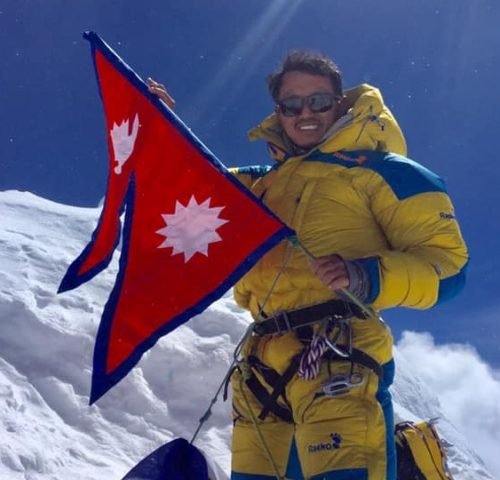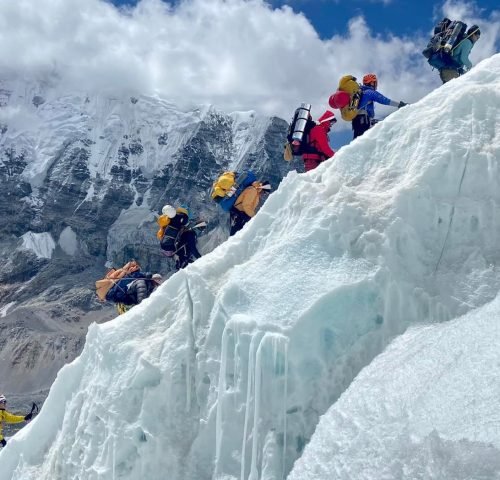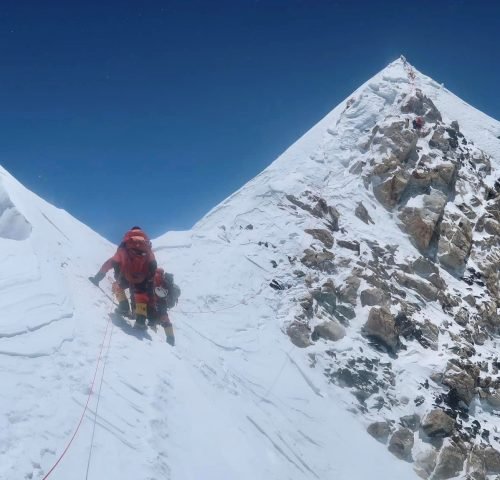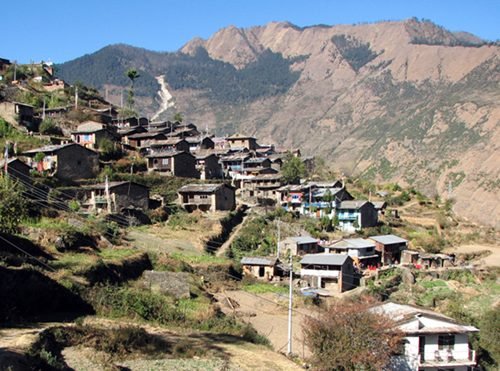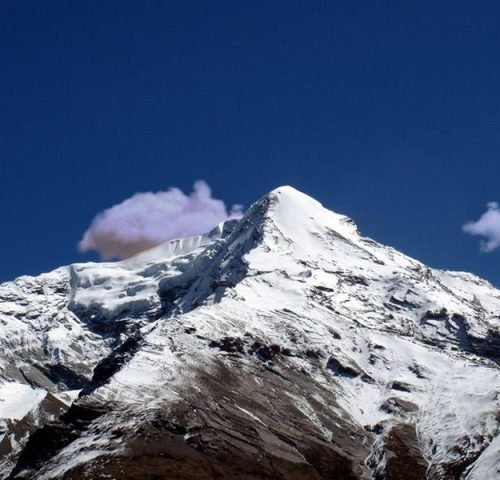Overview
The mount Lhotse [8516m ] is the world fifth highest mountain in the world is the ultimate dream of every climber. The main summit is on the border between Tibet Autonomous Region of China and the Khumbu region of Nepal. With Everest to the north and Nuptse to the west, Lhotse forms the apex of the massive horseshoe-shaped arc of the Everest massif. Despite the tremendous vertical relief of its South and Northeast Faces, it is the least prominent of the eight-thousanders due to the great height of the South Col between it and Everest. Lhotse's Western Face, recessed behind the head of the Khumbu Glacier in the Western Cwm, plays an integral part in the standard routes of ascent for both peaks; the name Lhotse, which means "South Peak" in Tibetan, further emphasizes the close relationship between the two.
The main summit of Lhotse was first climbed on 18 May 1956, by the Swiss team of Ernst Reiss and Fritz Luchsinger, members of the Swiss Mount Everest/Lhotse Expedition. Climbing to Lhotse is undoubtedly the ultimate mountaineering adventure and every adventure seeker wants to be a part of the rich history of Lhotse Climbing but the journey to the summit of Lhotse is not without challenges. With decades of experience in guiding groups to the summit of Mt. Everest, we have successfully made many people’s dreams come true.
Details Itinerary
Day 01: Arrival in Kathmandu 1300m and transfer to Hotel.
Our office representatives will welcome you outside the terminal hall and transfer you to the hotel. brief you about tomorrow’s activities and collect any documents required by our office.
Day 02: Expedition Preparation.
On the second day, we will complete all of our formalities, such as getting the required paperwork, permits, and other formalities required for our expedition, and we will begin making preparations for it. We will now prepare our luggage, go shopping, and double-check everything we need (especially medicines and essentials). There will be briefings on every part of the expedition, including all gear and equipment, the length of the trip, lodging options, base camp facilities, and all other aspects related to the expedition. It also gives you the chance to interact with and get to know your climbing companions and colleagues.
Day 03: Fly to Lukla 2800m and trek to Phakding 2600m. (3 hours’ trek)
We take an early morning flight to Lukla, where all Everest treks begin. You will need permission from the locals to continue exploring once you arrive in Lukla. This is the entrance to the protected Khumbu Region. To proceed, you will need the Khumbu Pasang Lhamu Entry Permit. The Trekkers Information Management System card has been replaced with this admission permission. The admission fee goes toward the development of the rural community.
Once you get into Lukla, eat breakfast at the lodge, and prepare luggage for the porters, the walking starts. To get to Phakding, there are a few ups and downs, as well as many prayer rocks (Mani in the local language). After you’ve settled into your Phakding lodge, take a short walk to the village.
Day 04: Trek to Namche Bazar 3340m. (6 hours’ trek)
Our trail passes through a pine forest, and we continue our walk on the trail that goes north up the Benkar valley. We cross the Dudh Koshi River and pass Chumoa and Monjo villages before reaching the entrance of the Everest National Park. Then, after crossing a suspension bridge, we pass Jorsale village and walk alongside the Dudh Koshi and Bhote Koshi rivers. ascend on a steep trail and reach Namche Bazaar, which is probably the biggest town in the Everest region.
Day 05: Acclimatization day in Namche.
We can tour Namche Bazaar, which is the primary town of the Everest or Khumbu region. We can hike up to the Everest viewpoint hotel and enjoy the sunrise over the Himalayas, including Mt. Everest, Lhotse, Nuptse, Ama Dablam, Thamserku, Kongde, and so on. If we are interested in a day hike, we can trek to Khumjung village. Today we also visit the Hillary School and a monastery that houses a yeti’s scalp.
Day 06: Trek to Tyangboche (3,870M, 5-6 HRS)
The trail climbs up from the town and then contours around the hillside, offering great views including Everest and Khumjung. Look out for spotted deer, Himalayan tahrs and birds – including the colorful (male) Danphe pheasant (Nepal’s national bird). The trail rises to Sanasa where the routes to Gokyo and Everest BC fork. The trail to the right then descends to cross the Dudh Koshi (past water driven prayer wheels) on a suspension bridge near Phunki Thenga (3,250m), the lowest point north of Namche Bazaar. It then enters the Imja Khola Valley and rises steeply, through dwarf conifers and rhododendron forest, for a two hour pull, to the hilltop village of Tengboche. Their famous Gompa is set against the backdrop of Ama Dablam, Nuptse, Everest, Kangtega and other peaks. At full moon in October/November they hold the colourful Mani Rimdu festival which includes masked dancing and Tibetan Opera in the monastery courtyard. Visit the monastery during the afternoon.
Day 07: Trek to Dingboche (4,360 M, 5-6 HRS)
Today’s trail descends to Debuche: a scattered stone village with a nunnery, chortens and long mani wall. Cross the suspension bridge over the Imja Khola and gradually ascend to Pangboche with views of towering Ama Dablam (6,856m) perhaps the most beautiful mountain in the Everest region). The trail then follows the river fairly closely as it gradually rises to its confluence with the Lobuche Khola and continues up to Dingboche: the last year-round Sherpa settlement in the region. Different views of Ama Dablam rise above the terraced fields of barley, buckwheat and potatoes. The fields are walled to protect crops from icy winds and animals during the short growing season.
Day 08: Second acclimatazation in Dingboche.
This is another scheduled rest day on the trek and will assist your fitness and oxygen intake at the higher altitudes to follow. An enjoyable 3-4 hrs side walk, 400m climb to Nangkartshang Gompa, on the ridge north of Dingboche village can be the best choice. This vintage point offers Mt. Makalu (8,463m) fifth highest Mountain in the world then trek to Dingboche for the night.
Day 09: Trek to Lobuche Basecamp (4850m, 4-5 hours)
On this beautiful day start after breakfast. The trail climbs to a ridge providing towering views of Taboche Peak and Cholatse and continues through Yak pastures before crossing a wooden bridge over a roaring stream to Duglha (4,620m). The trail then ascends steeply for an hour, up the gravely terminal moraine of the Khumbu Glacier. On the summit is a large group of stone-pile memorials to lost Sherpas and climbers. It also affords great border-views including Khumbutse, Lingtren, and Pumori. We sleep in tent at Lobuche basecamp.
Day 10: Trek to Lobuche high camp 5400m. (3-4 hours trek)
From basecamp we trek towards Lobuche High Camp. The path is steeper and rocky. We enjoy great views of Ama Dablam, Pokalde, Thamserku, Kntega and other mountains. In the afternoon our senior climbing guide will provide training on peak climbing techniques and proper way to use the climbing gears. Overnight at tented camp.
Day 11: Climb lobuche east then trek to Lobuche (4,940M, 4-5 HRS)
Today is the big day you are looking for in the whole trip. We wake up around 1 am and take hot tea/coffee and breakfast. After few hundred meters climbing through the rocky path then climbing on ice and snow. The guide fix a rope when and where it is required. While climbing through the rocky and glacier path fixed rope and man rope both will be used for safety. The summit of Lobuche peak offer one of the most panoramic mountain view than any other trekking peak. After enjoying summit views of Mt. Everest, Lhotse, Nuptse, Ama Dablam, Pumori, Cholatse, Thamserku, Kangtega and many more we then descend to the Lobuche village. Overnight lodge.
Day 12: trek to Goeakshep(5,160 M) - Everest base camp (5,364 M)
A long rewarding day, follow the windblown and rocky path along the barren moraine of the Khumbu Glacier to the last village at Gorakshep. After an early lunch, set out on the feint trail to the world’s highest Base Camp, on the Khumbu Glacier: opposite the dreaded icefall – the most dangerous section of an Everest ascent.
Day 12- 45: Climbing period
After few days’ acclimatization and observation, the Himalayas at the Everest Base Camp, we start up through the Icefall to the Camp1 early morning and return to our more comfortable Base Camp. Our practice leader at Base camp will guide all the members to become familiar with Icefall. We provide our valuable expedition members enough time to be acclimatizing with environment, altitude before we head to Camp3 and Camp4. Our Lhotse summit plan in general will be a single push on 7-9 days from Base Camp as follows: Everest Base Camp to Camp1, Camp1 to Camp2, Camp2 to Camp3, Camp3 to Camp4 to Summit to Camp4, Camp4 to Camp2, Camp2 to Base Camp and continue walk back to Lukla and fly to Kathmandu. The Summit program will be dependent upon weather and snow conditions.
Day 56: Fly back to Kathmandu or trek to Pheriche/Dingboche 4400m.
We may hike back to Pheriche while taking in the scenery. If you are on a tight schedule or need to return to Kathmandu sooner, you can pay an additional fee for a heli-flight.
Day 47: Trek back to Namche (3,44M, 6-7 HRS)
Today’s trail gradually descends to Deboche before a mild rise through rhododendron forest to the hilltop village of Tengboche which has an important monastery and great views in all directions. A long descent, leads to Phunki Thenga (3,250m) on the Imja Khola: the trek’s lowest point north of Lukla then pleasant contour walk back to Namche Bazaar.
Day 48: Namche - Lukla (2,642M, 6-7 HRS)
From Namche, the trail descends to more comfortable altitudes, passing through the friendly farming villages of Jorsale (where we exit the National Park), Monjo, Phakding, then crosses the suspension bridge at Thado Koshi before rising to Ghat and Cheplung.
Day 49: Fly lukla to Kathmandu.
Early in the morning you will fly back to Kathmandu and transfer to hotel/ relaxing or you can explore some heritage side in Kathmandu
Day 50: Final departure.
Our representative will drop you at international airport.
Cost Details
WHAT'S INCLUDED
• 4 Nights Hotele accommodations in Kathmandu at 3 star Hotel on Bed & Breakfast plan (before & after expedition).
• All land transportation arrival and departure transfer services to and from Airport both Domestic and International with other necessary surface transport as per itinerary.
• Domestic Cargo (40 kg included during domestic flight)
• (Kathmandu - Lukla - Kathmandu flight ticket) Kathmandu - Everest Base Camp - Kathmandu for expedition members, Liaison officer & Expedition staffs.
• Transport of food supply & expedition equipment to Base Camp & back.
• Expedition Permit fee of Mt. Lhotse
• Sagarmatha National Park Entry Permit, Local Grassland Permit Fees
• Full board in lodges during trekking to base camp and back.
• All kitchen tent, store tent, dining tents, toilet tent, table, chairs & cooking utensils for BC.
• Fresh Food (we serve hygienic foods) and fuel at Base Camp.
• Base Camp single sleeping tent & Mattress for each member.
• High Tents above Base Camp. C1, C2. High altitude food and fuel above Base Camp.
• Satellite Phone available at Base Camp, but nominal charge for use.
• There will be one personal professional climbing guide while climbing. one Sherpa climber for one person
• Service of Government Liaison Officer.
• Service of cook and kitchen boy at Base Camp.
• Insurance, Equipment allowance, daily wages of cook, kitchen boys & Liaison officer.
• 2 Expedition duffel bag for each member.
• Generator or Solar panel at Base Camp for light and charging.
• Agency service charge and Tax.
WHAT'S NOT INCLUDED:
• International airfare from/to your country.
• Nepal entry visa fee (can be obtained at the airport at upon arrival).
• Lunch and dinner during your stay in Kathmandu.
• Hotel accommodation after 4 nights stay in Kathmandu.
• Personal climbing gear and equipment above Base Camp.
• Personal insurance such as travel, accident, medical, emergency evacuation & lost luggage.
• Permit fees & customs charges, etc. for SAT phone, communication equipment & commercial filming.
• Expenses of personal nature such as drinks, laundry, postage, telephone etc.
• Tips and summit bonuses ($1500 is expected if summited)
Map
FAQs
1. How high is Annapurna Base Camp ?
Lorem Ipsum is simply dummy text of the printing and typesetting industry. Lorem Ipsum has been the industry's standard dummy text ever since the 1500s, when an unknown printer took a galley of type and scrambled it to make a type specimen book
2. How fit do I need to go trekking to Annapurna Base camp ?
Lorem Ipsum is simply dummy text of the printing and typesetting industry. Lorem Ipsum has been the industry's standard dummy text ever since the 1500s, when an unknown printer took a galley of type and scrambled it to make a type specimen book.
3. Where am I sleeping at night ?
Lorem Ipsum is simply dummy text of the printing and typesetting industry. Lorem Ipsum has been the industry's standard dummy text ever since the 1500s, when an unknown printer took a galley of type and scrambled it to make a type specimen book.
4. Which is the best season to Trekking in Annapurna Base camp ?
Lorem Ipsum is simply dummy text of the printing and typesetting industry. Lorem Ipsum has been the industry's standard dummy text ever since the 1500s, when an unknown printer took a galley of type and scrambled it to make a type specimen book.
5. Is drinking water easily available during the trek ? Is it safe ?
Lorem Ipsum is simply dummy text of the printing and typesetting industry. Lorem Ipsum has been the industry's standard dummy text ever since the 1500s, when an unknown printer took a galley of type and scrambled it to make a type specimen book.
6. How do we Travel from Kathmandu to Pokhara ?
Lorem Ipsum is simply dummy text of the printing and typesetting industry. Lorem Ipsum has been the industry's standard dummy text ever since the 1500s, when an unknown printer took a galley of type and scrambled it to make a type specimen book.
7. What food do we get in mountain?
Lorem Ipsum is simply dummy text of the printing and typesetting industry. Lorem Ipsum has been the industry's standard dummy text ever since the 1500s, when an unknown printer took a galley of type and scrambled it to make a type specimen book.
8. What happens if I get sick in the mountain?
Lorem Ipsum is simply dummy text of the printing and typesetting industry. Lorem Ipsum has been the industry's standard dummy text ever since the 1500s, when an unknown printer took a galley of type and scrambled it to make a type specimen book.
9. what kind of accommodation we can get during the trek ?
Lorem Ipsum is simply dummy text of the printing and typesetting industry. Lorem Ipsum has been the industry's standard dummy text ever since the 1500s, when an unknown printer took a galley of type and scrambled it to make a type specimen book.
